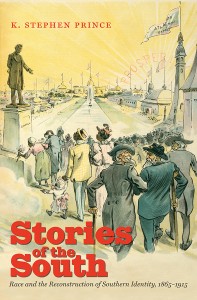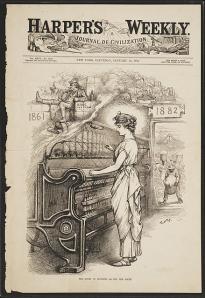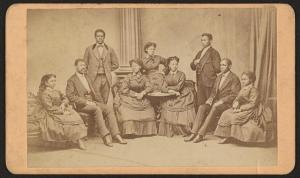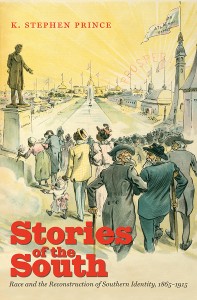Pop South interviews Stephen Prince, Assistant Professor of History at the University of South Florida, about his new book Stories of the South: Race and the Reconstruction of Southern Identity, 1865-1915, published by UNC Press in April.
 PS: The main title of your book is “Stories of the South.” Since this is a history book and not a book of literature, please tell readers of Pop South about the kind of stories your book examines.
PS: The main title of your book is “Stories of the South.” Since this is a history book and not a book of literature, please tell readers of Pop South about the kind of stories your book examines.
I use the term “stories” fairly loosely. Though I do analyze literary texts, I find stories about the South in a variety of other places: congressional debates, newspaper editorials, travel narratives, speeches, sermons, visual art, popular theater, songs, promotional material, writings on the “race problem,” political cartoons, and scholarly treatises. I cast my net pretty wide in order to capture the range of sites at which people grappled with the nature of the South in the fifty years after the Civil War.
PS: The subtitle of your book is “Race and the Reconstruction of Southern Identity.” When you write about “southern identity” between the Civil War and World War I, specifically whose identity are you concerned with? Whites? Blacks? Men? Women?

The book starts from a fairly simple premise. In the aftermath of the Civil War, the meaning of the South – defined as a region, a people, a civilization – was an open question. “The South,” as it had been, had ceased to be. The question was what the region would become. Over the next fifty years, Americans – northern and southern, male and female, black and white – debated the nature of the South. I use these conversations to chart a course from the racial egalitarianism of Reconstruction to the nightmare of Jim Crow.
That said, I’m not particularly attuned to the ways that individual southerners understood their “southern-ness” on a private, personal level. I’m much more interested in popular, public discussions of the South. References to “the Southern Question” were extraordinarily common in the late 19th and early 20th centuries. Northerners played an important role in these discussions, before and after the oft-cited “end” of Reconstruction in 1877. I argue that the South was re-defined in conversation between the sections. The ability to define the South carried with it enormous political power. To tell the story of the South was to control the South.
PS: Your book relies on sources of popular culture as a way to better understand the region. What types of sources did you use and was there a consistent message among those sources regarding the American South?

The message is definitely not consistent! Contestation and debate were the only constants. One of my goals was to bring cultural history to the study of the postwar U.S. South. Political and social history still dominate the literature on Reconstruction and its aftermath. Debates over the future of the South certainly occurred in the halls of Congress and on individual southern farms and plantations, but there was a much wider cultural universe in which the nature of the region was discussed. In order to understand the retreat from Reconstruction and the rise of Jim Crow, we need to pay attention to the larger cultural context in which political change occurred. Viewed from this perspective, a fantastic and phantasmagoric* pamphlet on the Ku Klux Klan is not just ephemera, it’s an important part of the cultural landscape in which power was won and contested. The same is true of the New South’s city boosting literature, Thomas Nelson Page’s plantation fiction, and the songs of the Fisk Jubilee Singers. Culture matters. Without understanding the stories that Americans told themselves about the South, we can’t understand the history of the South.
PS: One of your main arguments is that cultural production—particularly popular culture—is as important to understanding what shaped the South in the post-Civil War era as are political and economic changes. What role did popular culture play in shaping contemporary ideas about the South in the 19thc.?
Though I try to avoid simplistic cause-and-effect analysis, a large-scale change-over-time argument structures much of the book. In the first years of Reconstruction, northerners seized the power to re-imagine the South. By the 1880s, however, conservative white southerners had realized the significance of what we might call the cultural front in the war on Reconstruction. By the early twentieth century, northerners were largely content to defer to white southerners on matters relating to the South, particularly where race was involved. Throughout, African-Americans told their own tales of the South. In the process, they offered eloquent testimony to the power of culture and public opinion. Go read Frederick Douglass’s last speech on lynching or the cakewalk scene in Charles Chesnutt’s The Marrow of Tradition. As Douglass put it, “words are things.” The way that people described affairs in the South – the words they used, the stories they told – mattered deeply.
PS: Last, but not least, what about your newest research project might interest readers of Pop South?

I’m now writing a book about the 1900 New Orleans riot, tentatively titled The Ballad of Robert Charles: Race, Violence, and Memory in the Jim Crow South. The riot has a place in all the big books on the rise of Jim Crow, but no one has attempted a full scholarly study since William Ivy Hair’s 1976 Carnival of Fury. The violence in New Orleans started when a black man named Robert Charles shot and killed several white police officers. Over the new few days, white New Orleanians took their revenge on the city’s African American residents, killing at least five and wounding dozens more. When the authorities finally located Charles, an enormous gunfight broke out. Trapped in a second story loft, Charles shot several more white people before he was killed. The riot quickly became a national story, spawning extensive newspaper coverage and becoming the subject of Ida B. Wells-Barnett’s pamphlet Mob Rule in New Orleans. Though white and black elites did their best to eradicate the memory of Robert Charles, evidence suggests that he lived on as something of a folk hero among working-class African Americans in New Orleans and beyond.
The book’s title – The Ballad of Robert Charles – comes from a 1938 interview that folklorist Alan Lomax recorded with jazz legend and New Orleans native Jelly Roll Morton. “They had a song out on Robert Charles,” Morton recalled. “I used to know the song, but I found it was best for me to forget it. And that I did, in order to go along with the world on the peaceful side.” The ballad of Robert Charles was too explosive to remember, too dangerous to sing. Following Morton’s lead, I hope my book will be much more than a story about Jim Crow New Orleans. It will also be an exploration of memory, forgetting, historical silences, and the power of the past.
*This is your word for the day, children.

